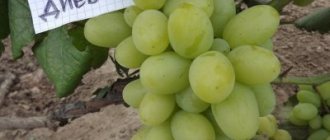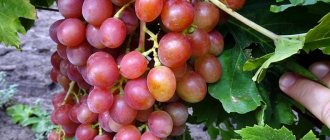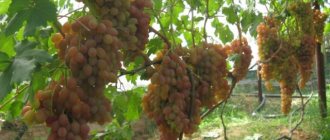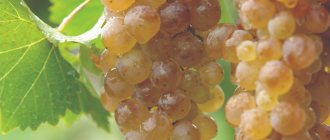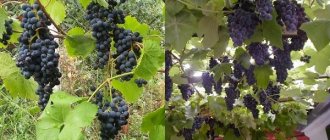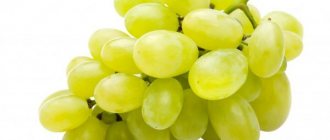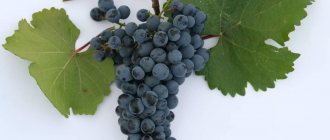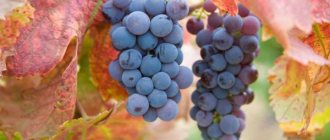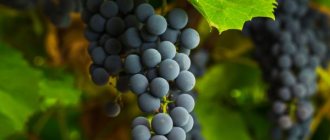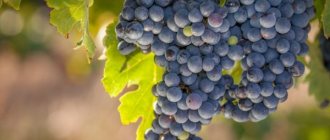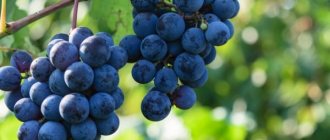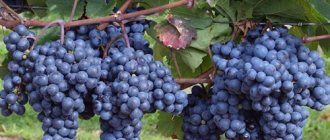Fruits and berries » Grapes
0
1165
Article rating
Kira Stoletova
Among the variety of varieties, Supaga grapes are distinguished by their unpretentiousness and frost resistance. Suitable for growing even for beginner gardeners. Belongs to early ripening species. In addition to using the fruits, the crop is planted for decorative purposes in landscape design.
Characteristics of Supaga grapes
Description
“Supaga” is a hybrid bred by Latvian breeder Paul Sukatnieka. The new variety was given life by the French early varieties “VITIS DVIETES ZILA” and “MADELEINE ANGEVINE”.
The unusual name of the grape is interpreted simply: the first syllables of the surname, the name of the breeder and his wife (su - Sukatnieka, pa - Paul, ga - Gaida) together created a new word.
Origin of the variety
In 1953, work began in Latvia to create local grape varieties that were resistant to the region's climate. After 6 years, based on the varieties Madeleine Angevin and Dvietes zila, many hybrids were bred, of which the Supaga variety was chosen as one of the most promising in 1968.
The creator and tester of the variety is Sukatnieks Pauls. The first two syllables of the name contain the initial letters of his last name and first name, and the last “ha” in honor of the breeder’s wife Gaida.
The resulting hybrid, in addition to the Baltic region, is popular in many countries:
Characteristics
“Supaga” is a universal variety. Its fruits are used fresh, as well as in cooking: jams, mousses, and salads made from this variety are aromatic and tasty. Good universal varieties also include “Baikonur”, “Beauty of the North” and “Moldova”.
Ripening period
From the beginning of spring budding to the ripening of the harvest, 115–120 days pass, which gives the right to the “supaga” grape to be called an early variety. Harvesting takes place from the beginning of August and may end in early September, since ripe grapes do not spoil on the bush, but acquire an additional dose of sugars and aroma.
Bush
The bush has great growth power, the seasonal growth of the vine is 80 - 90%, which in length units is equivalent to 5 - 7 meters. The total growth area of an adult bush can be 5 m2.
The foliage gives this variety a special charm: it is dense, dark in color with red veins, it is often used to decorate personal plots and objects located on it (arches, gazebos, pergolas).
Bunches and berries
The clusters of “supaga” reach 15–30 cm in length and “gain” a mass of 350–600 g. The shape of the brushes is a regular cone with side “wings.” The structure of the bunch is not characterized by high density, but the quality of the berries does not suffer from this.
The average weight of berries ranges from 3 to 5 g, size - 12-15 by 12 mm. The round grapes are colored white-green, but prolonged exposure to the sun after ripening gives their skin a “light tan” - an amber tint.
The pulp is juicy, the skin is thick, fused with the pulp, but is easy to chew. A small number of small seeds does not spoil the taste.
Sugar accumulation is quite high - 17 - 20% with an acid content of 5 - 8 g/l.
Taste
The sweetness of the “supag” is harmoniously combined with a pleasant sourness. The taste of the fruit is berry, with notes of honey and strawberry. The aroma is light nutmeg.
Productivity and frost resistance
Supaga grapes have remarkable yields. With good care, up to one hundred kilograms of fruit can be removed from one bush.
Victoria, Novy Podarok Zaporozhye and Rkatsiteli also demonstrate high yields.
The ripening of berries is considered early from 115 to 120 days, full maturity is achieved at the end of July. Fruitful shoots from 80 to 85%. The number of tassels per shoot is 1.5-1.8.
The harvest is stored on the shoots for a long time . At the same time, it does not lose taste, quality and commercial properties. The variety is frost-resistant down to minus 25 degrees Celsius. It can be both covering and non-covering.
The vine can easily bend to the ground. Spruce paws are used for shelter. In this case, the sleeves are quite long and contain a large amount of perennial wood.
With such shelter, a supply of vitamins and nutrients necessary for the bush is provided. This allows the grapes to easily withstand weather conditions and resist pests.
Comparison with analogues
Next, we will try to compare “supaga” with another Latvian variety (“guna”), as well as those most similar to it.
| Sign | Variety | |||
| Supaga | Guna | Arcadia | Beauty of the North | |
| Ripening period | 110 days | 100-110 days | 115-125 days | 100-110 days |
| Frost resistance | Up to -30 °C | up to -26ºС | up to -21ºС | up to -26ºС |
| Yield per bush | 50-70 kg. | 8-10 kg. | 30-50 kg. | up to 12 kg. |
| Bunches | 350-600 gr. | 140-160 gr. | 500-700 g (up to 2 kg) | 250-500 gr. |
| Taste | berry, with notes of honey and strawberry | subtle isabelle shade | unobtrusive with light nutmeg | tart with herbaceous flavor |
| Color | white-green with a pink tint | pink | white | white |
| Disease resistance | average | average | average | average |
| Shelf life | Few weeks | up to 2 months | Few weeks | A few months |
| Sugar content | 17-20% | 15-20% | 14-16% | 14-17% |
| Acidity | 5-8 g/l | 7-9 g/l | 6 g/l | 8-9 g/l |
Forum statistics
207036 Messages in 1634 Topics from 5593 Users. Last user: Amaya Last message: “Let's talk about the weather in Vash...” ( Today at 07:52:22 ) Latest messages on the forum.
Now on the forum
31 Guests, 8 Users
Users in the last 15 minutes: 64nikolay64, Svetla777, Tihiy, Marshal, Nikolay S., therapist, Liza, lomakin1969 [Blocked] [Section Moderator] [Forum Moderator]
Maximum online today: 77 . All-time maximum online: 2758 (28 July 2021, 17:22:51)
Users who visited the forum in the last 24 hours
Total: 295
(Visible: 294, Hidden: 1) 1963, 64nikolay64, Svetla777, Quiet, Marshal, Nikolay S., therapist, Liza, Capricorn, lomakin1969, Alexander Vl., Elvira2017, Andrey76, Slavka, Mikhail77, ElenkaF, Tatyana B, Alex65, Cherkessk, Eugene, zsb, leonidych, vladimirM, yotmast, mers, Serg1707, SNovichek, hanter64, znakomij, Alexander K, Vardan, Sergey Fer, Anatoly Sivkov, Alexey V, Ilya 77, Andrey Gladilin, Tatyana A., Belgorodets, in Astrakhan , Oksana Kopp, sem_en, Vladimir 153, skier, Igor Viktorovich, slavalimon, Primorets, OlgaOs, SANYCH, 31rus, mystic69, DorontsovPeter, Andrey Tsvetkov, Buba, igor222, Elena Z, vlad51, Kenig, Nikolay Rex, Sergey 1965, Vladimir Buturlakin , DSW, psv1960, Dmitry 77, Vasily V., Vyacheslav03, Natalia Nikolaevna, Sergey Tashchiyan, Igor Sergeevich, alexsandr, kvg, Pioneer, Ekaterina Polyanina, nicson7, Elena Aleshchenko, Alexander-ask-34, Verona, Igor F., Taker , Henry, Yuri72, L.A.P., Gaivoronsky Yuri, Sergeevich, Sergei Chistokletov, Svetlana Streletskaya, Galinka, Alexey Deminov, Naumov Igor, Vyacheslav136, Gloomy, Katrin, AndSanych, Mikhno Alexander, Ded31, Filippov Oleg, Vladimir ++ , Mikhail Alekseevich, Lydia58, ALEXANDER BRYANSKY, Vladimir-kanevskaya, DIL, Amber7394, Marina Protasova, TITOVA LYUBOV, Linx, alexander66, Natalya M, Mikhail Fesenko, Amaya, Alexander71, Boris 1952, tsv, Maximilian, 25nata35, nadia, GALINA A NOKHINA , Igor_K, Alexander Kolesnikov, Ivan Levin, Pitko, weather forecaster, eSAa, cecet71, atseton, Alexander Smirnov, Vladimir Kostochkin, Vladimir Berdnikov, Gocha, pioneer-2, LeXa_KoT, Sergey 61, Sergey Yuryev, Erem, alexss, Evgeniy52, Skif, Vladimir Kovba, dayton, Yuri Semyonov, N.A. Sokolov, Pavlentiy, Sa-shura, Volgogradka, Dmitry Anatolyevich, Grandfather Igor, Andrey Lis, Bublichenko Alexander M, Marina Krymskaya, stenlly2010, irahelm, Vyacheslav Vladimirovich, Vladimir Shilov, Aprel, Badaev Dmitry, gheo55, Yura, y_fed, rambo, Yagodka, Valentina Ivanovna, Kryn, oleg9f, DED2, Svetlana Korotina, Zavezen Oleg Ivanovich, Eduard., santra, L2k2m7n, Alexander48, Viknik, Andrey 31, m2d, Valery Rastorguev, Soshnin Yura , Amateur gardener, Galina, Vasily1111, gardener, marlin64, Salex, sergei, Sergey Ko, Ramiz, viktor_, kosmos, potap05, Yuri 36, VitalySD, Inna161, Vova Kapran, Vladimir Shcherbinin, Valerie, niy1, cfibr, Andrey68, kulol3 , thanatos, Serzh1978, Realist, Artur53, max2008-01, LOZA, AlexanderD, Grandfather Young, Natasha, Zayac, ketch, Rita, alx-74, Iv Iv, Alexander150, Igor K, Vasily Viktorovich, VeraNiK, kdm57, Veniaminovich, Boris Sokolyansky, 77volt, , vikbublik, neposny, Evgen, Victoria Aleksandrovna, Serezha 64, Wintel, Airbone, teri, Sergey Lomonosov, Khramov, serginio, Leonty Yarygin, Irina O., Ser, Nadezhda Grig, Lyubov S., netolya, Saisan, Agryzkov Alexey, Vadi, Zinaida, Vadim, Alexander Taganrog, Sukhonos Sergey, Snezhinets, evgen_26, nau_63, Masha_gardener, Gennady163, krasnovlad1, Alexander Zinoviev, Vasily 53, Roman Fedorovich, TIS, Alexey Sergeevich, arnyusha, Zheka, Nurtas, kradievska, nick041 , Valentina Medvedeva, Sergey43, Andrey S., Nikolay Lipunov, Mst, Vertuoz2, Vladimir VS, NatalyaMed, freesia, Kinna, Mikhail Michurinsk, alekcsan1, VALERY TAMB, Sasha57, MikhAf, Y_Azer, Andrey Beribesov, hunter1955, nut lover, Keys, Ivan Shmelev, Pestik, anton_slash, Nadymchanka, Sergey 31, Volgar, Pavel 64, Tatyana Volzh, Elektronik_t, Alexander 61, spotlight, Alexander Guy, Cheprak, Pirko Alexander, vladimirvrn
Features of cultivation
The agricultural technology for growing the “supaga” variety is simple. The grapes accept any soil, but the site should be windless and sunny. It is recommended to water 3–4 times a year in small volumes (2 buckets for one bush); to preserve moisture, the root zone of the bush can be mulched with mown grass or onion peels.
Reference! Fertilizers containing potassium, phosphorus and nitrogen are applied in the spring, and organic matter (humus or manure) is applied once every 2 to 3 years.
Trimming
The best time to prune “supaga” grapes is the cold season, before the juices begin to flow on the plant. As a result of this operation, 4 - 8 buds remain on the vines, on a bush formed on a single-strip trellis - 30 - 35 buds, with a two-strip molding - 60 - 70 buds.
During the period of ripening of berries, rich foliage can be harmful, so excess leaves surrounding the bunches and preventing them from absorbing sunlight must be torn off. Also, to enlarge the fruits, it is advisable to remove all single and weak stepsons from the bushes.
Diseases and pests
“Supaga” is resistant to mildew, oidium, and gray rot. But preventive treatment twice a season will not hurt. Chlorosis and phylloxera pose a danger to this variety.
The plant should be treated with a solution of copper sulfate (1%) to prevent phylloxera, and feeding with microelements during watering will help combat chlorosis.
Wintering and storage of crops
“Supaga” is considered a non-covering variety. A powerful root system can help the above-ground part of the plant survive frosts of -25 -30ºС. But in northern latitudes it is still better to play it safe and insulate at least young seedlings.
The storage period for berries is 1 – 2 months at a temperature of +5 – +8ºС. The dense skin allows the fruits to safely endure long-term transportation.
Regions
In addition to its native Baltic latitudes, “supaga” successfully acclimatized to the temperate latitudes of Russia (Moscow region, Yaroslavl, Smolensk, Tver and others), it also mastered regions with a harsh climate (Siberia, the Urals).
Formative pruning of supaga grapes
The only thing you need to pay special attention to is the amount of harvest - excess bunches are removed at the very beginning of the growing season. This grape variety can be described as a plant with rapid ripening of the vine - almost 80% are fruitful. But in order for the harvest to be of high quality, you need to adhere to several rules when formative pruning:
- Trimming the shoot should be no more than 6 buds from the ground;
- When pruning a bush, leave about 40 eyes in total;
As for formative pruning for the winter, minimal correction is made, since the Supaga grape variety does not require covering or insulation during cold weather. High frost resistance ensures that the plant will overwinter without complications.
Photo
Next, check out the photos and reviews about the “supaga” variety.
conclusions
- “Supaga” is considered a table variety, but recently it is increasingly being cultivated as a technical variety.
- Its use is universal: from eating fresh berries to culinary delights prepared on its basis.
- The requirements for caring for the plant will be easily met even by a novice winegrower.
- The combination of external characteristics of grapes with yield indicators, taste characteristics and resistance to various diseases makes “supaga” a desirable variety in every household plot.
You might be interested in learning about other varieties
Reviews
“Supaga is a very productive variety. Exceptionally frost-resistant and suitable for gazebos.” Igor Mikhailovich
“I liked the taste, almost like strawberry, but practically without acid.” Valentin Sergeevich
“Very original taste, fruity-pineapple with a hint of tropical fruit, very sweet. In general, I liked the variety, I don’t regret planting it.” Sergey, Rostov-on-Don
